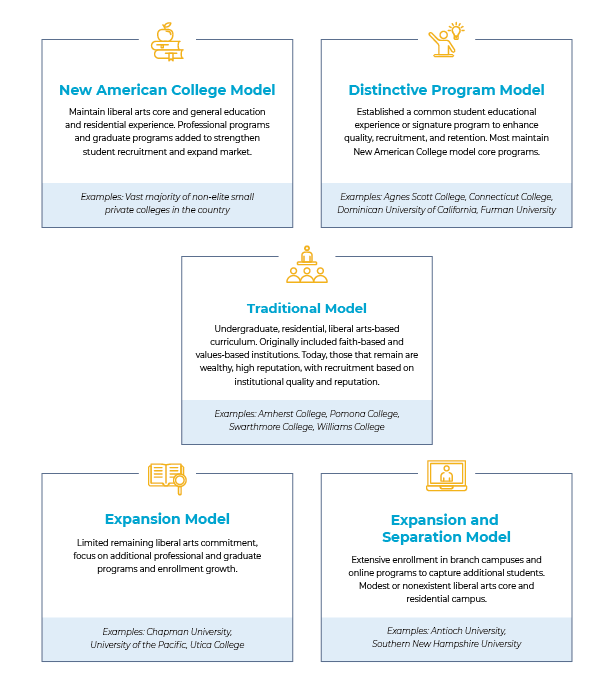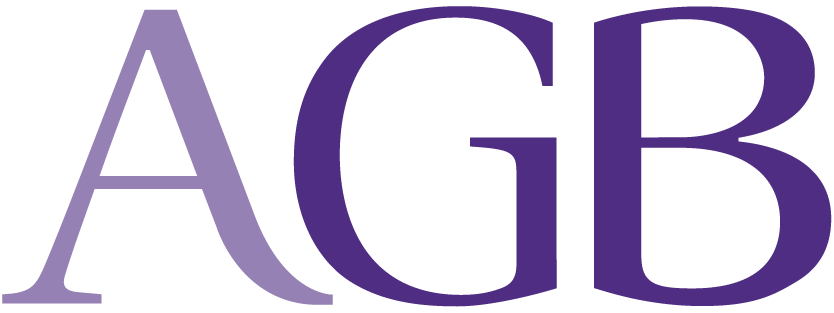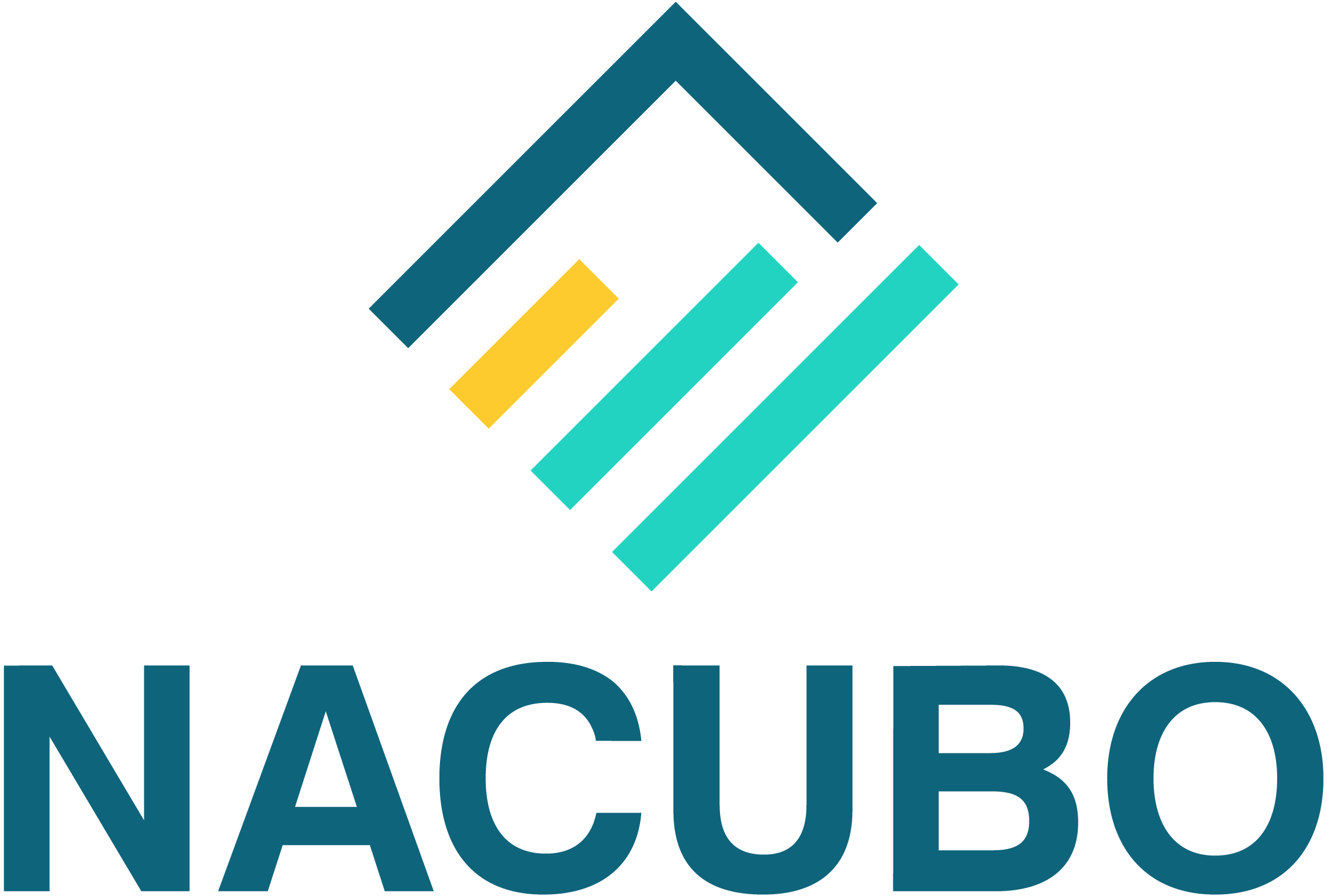Boardroom Conversations:
What Are Our Options?
If the institutional assessment and underlying data confirm that an inflection point has been reached, the reality for leadership of a small college or university is that they have one of three choices. The first is to stay the course and if that is the path chosen then it is incumbent on management to ensure they have put in place the business infrastructure described above—leadership roles and responsibilities, resiliency of governing model, efficacy of strategic planning process, et cetera. A second path, outlined in the situational awareness template, calls for material changes in, or transformation of, the traditional institutional business model with multiple options to choose from. While a third path, based on a distinct set of factors, may be to seek an affiliation, partnership, consolidation, or merger.
In her monograph The Small College Imperative: From Survival to Transformation (AGB, 2017), Mary Marcy captures the essence of the discussion board members and senior leadership may want to consider when the second pathway, a business model adaption or transformation, is the most viable option. In her work, Marcy cautions against falling into the trap of the “incrementalism” that Townsley discussed in the strategic planning section, when she observes that short-term responses do not constitute a long-term solution to the challenges an institution may be facing.
As a part of the situational awareness assessment, board members and senior leadership may need to consider alternative options.
Marcy believes this calculus is particularly relevant today: “Small private colleges and universities have not experienced a failure in execution at the campus level, but a fundamental change in financing, demographics, and priorities forced by changes in the external environment. Short-term tactics may enable an institution to survive without long-term damage for a while. But barring a dramatic change in external fiscal and demographic realities, these strategies will not return the campus to the days of (traditional) stewardship.”1 To achieve stability, which she defines as both fiscal as well as mission and educational quality, leadership must be prepared to “adapt to the changing environment by adopting a business and educational model that reflects these emerging realities.” She offers, in addition to the traditional small college business model, four alternatives (see below) that are under active consideration among higher education institutions today ranging in impact from relatively modest adaption to transformative changes.2
The National Landscape for Small College Operational Models

Mary B. Marcy, The Small College Imperative: From Survival to Transformation (Washington, D.C.: Association of Governing Boards, 2017), 31.
Marcy notes that “determining which model is most likely to be effective involves a careful review of institutional mission, market forces, campus location, infrastructure capacity, and institutional strengths. By evaluating these factors, governing boards and presidents can move toward a model that will distinguish the campus in its region, build institutional quality, and strengthen fiscal capacity.”3 Marcy outlines an approach for how institutional leadership can accomplish this through a process of (a) institutional assessment, (b) the selection of an appropriate business model, and (c) organizational transformation (see below).4
In Marcy’s analysis, for an institution to thrive and have a sustainable future, leadership must move beyond short-term measures and embrace a vision of the future more in step with the reality of its operating environment. Leadership must have a situational awareness not only of “where the institution is today, but more importantly where it is headed.” With this level of understanding, governing boards and presidents can evaluate each of the available educational business model options and select the one most appropriate to their institution. They can then more successfully marshal stakeholder buy-in and align strategy and resources to promote successful execution.5
Adapting to a Changing Environment for Small Colleges:
From Survival to Transformation
Assess
- Affirm essential elements of mission
- Identify unique characteristics and strengths of institution
- Evaluate likely student demographic profile
Select
- Most promising of small college models
- Strategic vision based on choice
Transformation
- Align programs and systems
- Develop multiyear sustainable budgets
- Align fundraising and marketing
Mary B. Marcy, The Small College Imperative: From Survival to Transformation (AGB, 2017).
As a part of the situational awareness assessment, board members and senior leadership may need to consider alternative options to the models proposed by Marcy. Leadership must assess not only the finances of the institution, but also its competitive position, future demographic trends, and requirements for future investments.
In an AGB article on mergers and acquisitions, Rick Beyer refers to this latter item as a “quality of earnings” analysis. He suggests that such an analysis will “help to quantify an institution’s prosperity gap—essentially the distance between current financial performance and a prosperous future.”6 At other times, institutional leadership has referred to this prosperity gap as “revenue neutrality”—that is, the actual amount of revenues required to cover the level of expenditures necessary to support all of an institution’s obligations. In this instance, Beyer notes this level of financial analysis will “enable an institution to add back expenses in areas where underinvestment is present (for example, new programming, technology, people, marketing, support services, headcount deficiencies, et cetera) and to quantify the amount of additional annual operating margin necessary to fully invest in strategically critical areas.”7
Depending on the size of the “prosperity gap,” governing boards and presidents, in consultation with the CFO, are better able to assess their options and thus determine the most appropriate path forward. As part of a due diligence process in determining whether a partnership, merger, or affiliation is practicable, there is a series of questions and actions developed by AGB (available for download below) that boards and senior leadership should consider when engaging in the tough conversations required for such decisions.8 The importance of these conversations begins with the knowledge that partnerships, mergers, or affiliations are not equivalent decisions, as each have their own unique requirements and impacts on the institution. Additionally, the timeliness of these discussions is critical if the institution is to put itself in the optimum bargaining position so that it can negotiate from a position of strength rather than weakness.
Just as importantly, they need to be informed by an understanding of the institution’s status in terms of meeting its mission, but more importantly where it is headed to ensure that any business arrangement entered supports both core mission and student success. These conversations are not easy, but boards and presidents must be cognizant as to when they are required (by fiduciary duty) and have the institutional resiliency to not be constrained by the past.9
1 Mary B. Marcy, The Small College Imperative: From Survival to Transformation (Washington, D.C.: Association of Governing Boards, 2017), 2.
2 Marcy, The Small College Imperative, 5.
3 Marcy, The Small College Imperative, 9.
4 Marcy, The Small College Imperative, 2.
5 Marcy, The Small College Imperative, 4.
6 Rick Beyer, “Mergers and Affiliations—Questions Boards Should Ask,” Trusteeship Volume 27, Number 3 (May/June 2019).
7 Beyer, “Mergers and Affiliations—Questions.”
8 Beyer, “Mergers and Affiliations—Questions.”
9 Beyer, “Mergers and Affiliations—Questions.”
Related Resources
Association of Governing Boards. “Mergers and Affiliations Toolkit.” (Toolkit). https://agb.org/mergers-and-affiliations-toolkit/.
Beyer, Rick. “Mergers and Affiliations–Questions Boards Should Ask.” Trusteeship Volume 27, Number 3 (May/June 2019). https://agb.org/trusteeship-article/mergers-and-affiliations/.
Marcy, Mary B. The Small College Imperative: From Survival to Transformation. Washington, D.C.: Association of Governing Boards, 2017. https://agb.org/reports-2/the-small-college-imperative-from-survival-to-transformation/.








